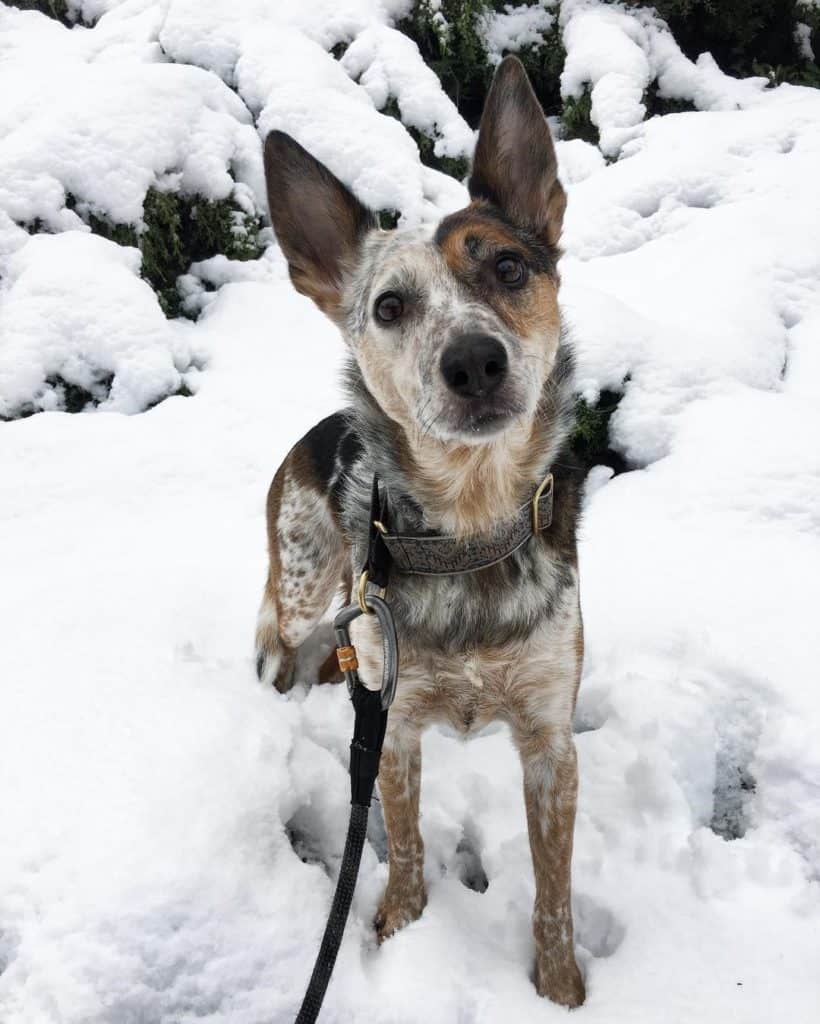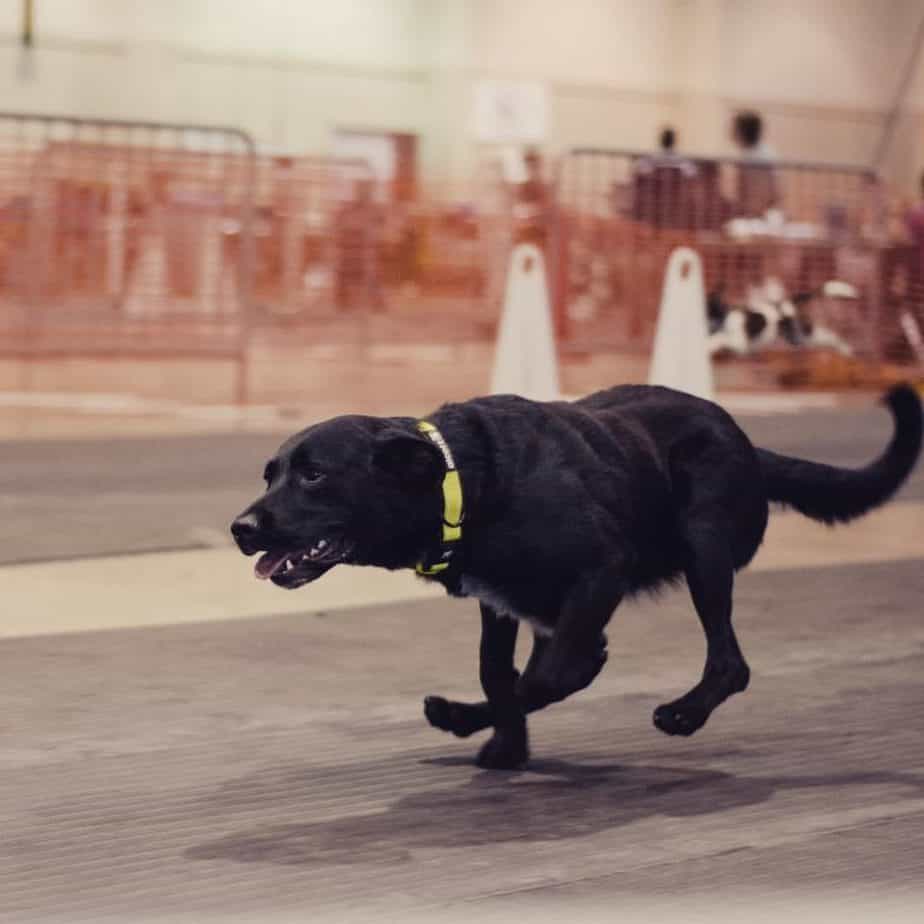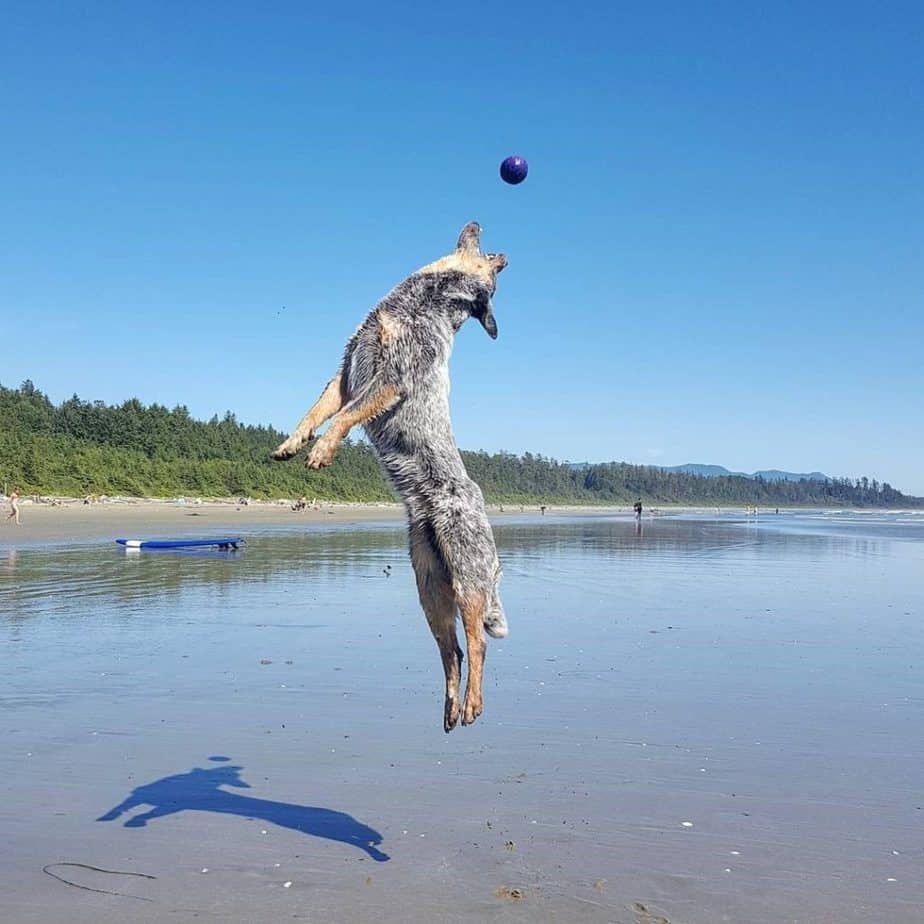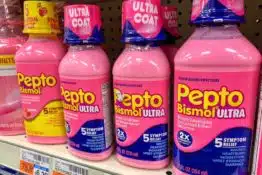
Blue Heeler Lab Mix Facts
Blue Heeler/Australian Cattle Dog and Lab Retriever Mix
The Blue Heeler Lab Mix is a result of breeding a Blue Heeler (sometimes referred to as Australian Cattle Dog) and Labrador Retrievers. The Blue Heeler/Australian Cattle Dog and Labrador Retriever make a good and cute mix, and the puppies combine an outgoing friendly personality from the Labrador Retriever, and sometimes the stubbornness of the Blue Heeler. But one things for sure, the Blue Heeler Lab mix will show traits such as being strong, energetic, and lovable. Mixing the two breeds can sometimes be unpredictable, but knowing a little bit of their individual personalities can help you understand them better.
The Blue heeler are good herding dogs, which can withstand hot and rough climate. They’re very resilient and are known for its outrageous stories of being strong dogs. The Labrador Retriever is among the most popular dog in the US, and they’re known to be great as therapy and service dogs. Labrador Retrievers show amazing personality traits like being mellow and its eagerness to please its owner.
3 Reasons Why You Shouldn’t Get a Blue Heeler Lab Mix
The personalities of mix bred dogs are hard to predict, and Blue Heeler’s show some personality which isn’t necessarily pleasing for most families. Labradors, on the other hand, have several personalities features favorable to most persons, and it’s hard to guess what personality your pups may have.

Requires a firm hand and discipline, especially in training. Both dogs are undeniably smart, but unless you have a firm hand or a strong personality to train them, getting them to the behavior you want them to have may be hard. Blue Heelers, in particular, are very stubborn and are better off with experienced dog owners.
3 Reasons Why You Should Get a Lab Heeler Mix
Perfect family dogs because of both the Blue Heeler and Labrador exhibit traits of being loyal and protective. You can expect that your Labrador Heeler mix will be a perfect companion for your family, as well as your children. In addition to being loyal, they also make great protectors for your children. Blue Heeler Lab makes a loyal and smart companion. Regardless of the family, they’re in, you can expect they’ll be by your side. Labradors and Blue Heelers are well known for their traits of being loyal and smart, and Labradors are most especially known for their mellow demeanor
Good companion for intense activities because both breeds have high energetic levels. Combined, the Heeler and Labrador mix need to have activities where they can release their energy such as going on a run, walk, or even hiking. The breed is perfect for someone who has an active lifestyle and wants a pet who can keep up.
The One Thing Pet Owners Regret Not Doing Until It’s Too Late
Is your pet safe?
1 in 3 pets will need emergency veterinary treatment each year and it is estimated a pet receives emergency care every 2.5 seconds in the U.S.
The average cost of treating a broken bone in dogs is $2,700. Cancer treatments? Up to $10,000.
It’s why so many pet owners say their biggest regret isn’t the vet bill—it’s not having pet insurance when they needed it most.
Ask yourself: “If an unexpected $5,000 vet bill hit tomorrow, could I afford it?”
If the answer is no, it’s time to get covered.
Take a look at Lemonade. They have a great app that actually works, they have an instant chatbot that is faster and, dare we say it, friendlier than most companies’ “real” customer service and a quick scroll through Reddit will uncover… people are really vibing with this brand.
So go check them out and take a look. It takes less than a minute.
Effective helpers for labor-intensive work. Considering how active the breed is and their history, the mix is a perfect choice for people who need help with herding cattle. Blue Heelers, in particular, were bred specifically to help raise cattle, and with the intelligence of Labradors, the mix will be a perfect companion for your daily herding job.
Appearance, Personality, and Traits of Blue Heeler Lab Mixes
| Weight | Male: 14 to 36kg
Female: 12 to 32kg |
| Height | Male: 17 to 25 inches
Female: 16 to 24 inches |
| Size | Medium to Large |
| Coat Type | Short, thick, and weather resistant undercoat (Labradors), or blue or red speckled dark or cream marks (Heelers) |
| Coat Color | Black, Chocolate, or Yellow (Labradors), or Blue or Red (Heelers) |
| Amount of Shedding | Moderate to Seasonal shedding (Labradors), or Constant (Heelers) |
| Life Expectancy | 10-16 years |
| Temperament | Energetic, Intelligent, Loyal, Outgoing, Playful, Responsive, and Social |
Labradors and Blue Heelers vary in Appearance. Labradors are usually large and sport a double coat of either yellow, chocolate, and black fur. They can be as tall as 24 inches and weight up to 80lbs. On the other hand, Blue Heelers are usually medium sized, sporting either a blue or red fur. Blue Heelers are shorter and lighter than Labradors, with an average of 20 inches in height and 50 pounds in weight. Labrador Heeler mixes will most likely have both the color and patterns of either breed.
When it comes to the temperament of Blue Heeler Lab mixes, it’s safe to say that you can expect a good outcome. Labradors are known for being friendly, loving, curious, and pleasing personalities, especially around children. They have a good laid back nature and love to work and are extremely intelligent. The Blue Heeler displays personality just as great as the Labradors, and they are highly loyal, smart, and protective. A Labrador Heeler mix may show a combination of a resilient and laid back personality.
Heeler and Lab Mix Puppies for Sale
In finding a Heeler and Labrador mix, be mindful of where the puppies come from. The task can be daunting at first, but it’s pretty easy once you know the basic. You can start with:
- Do a quick search online of who the reliable breeders in your area or someone is already selling one.
- Ask your friends for recommendations because at least you know the likelihood of you getting a good source is higher than getting the information from a stranger.
- You need to cautious with where you’re buying your puppies, and you can take steps in order to avoid experiencing any complications such as:
- Buying from a reliable breeder who is willing to answer your questions. Most often than not, a reliable breeder is more than willing to answer your questions, in order to give you peace of mind, and help you resolve any pre-existing conditions the pup may have. If they can’t be honest with you, or simply refuse to answer, walk away.
- Know who the pup’s parents are and their genetic history. Breeders should be fully acquainted with the parents of the pup, and they should be aware of the health problems which your pup will most likely have because of their parents.
- Check out the breeding environment of the puppies. If it looks unclean and horrifying, run. You want to buy from someone who knows how to take care of dogs, and not from someone who runs a puppy mill.
- Ask for documentation. Don’t be afraid to ask for documents about your pup, because the breeder should understand that you’re just trying to safe and sure about your pup’s health.
Grooming Your Lab Retriever and Blue Heeler Mix
One thing’s for sure, Labrador Retriever and Blue heeler mix tend to shed a lot, which is why you need to take close attention in their bathing, brushing, and grooming requirements. Any healthy dog requires a good grooming regime, and most often than not its physical manifestations is an indication of their health within. Grooming your Blue Heeler Lab mix is easy, and here’s what you can do.
- Regularly brush your pup’s coat, in order to remove old hair and encourage new hair growth. Moreover, this will also prevent extreme shedding which is most often than not an extreme inconvenience.
- Give baths as frequent as every other week to keep the coat clean and eliminate unwanted smells. A good bath helps to obtain a healthy skin and coat.
- Trim their nails in other to prevent unnecessary scratching incidents, especially on children. Brush them regularly to eliminate loose furs.
Grooming your dog has a lot of benefits, and their outward appearance says a lot about how you take care of them. A dog such as the Labrador Heeler mix requires a good brushing, as they have a complex and beautiful coat color.
Labrador Heeler Mix Health Problems
Blue Heelers have a longer life expectancy than Labradors, Blue Heelers having 12-16 years and 10-12 years for Labradors. You can expect that your Heeler Labrador mix will most likely have a life expectancy somewhere a long 10-16 life span. Generally, both the Blue Heeler and Labrador are healthy breeds and they don’t share a lot of congenital health issues. Despite being healthy breeds, the health of a Labrador Heeler mix can be unpredictable.
In order to discover what the Labrador Heeler Mix health will be like, and understanding of the individual health conditions of their parent dog is necessary.
Labradors are known to suffer from obesity, which often leads to other health problems like diabetes, arthritis, and thyroid problems. Blue Heelers, on the other hand, are more known to suffer from joint conditions and bone problems. Here are some health problems you need to watch out:
- Hip and Elbow Dysplasia – this is common among medium to large size dogs, and Labrador Heeler mix falls under this category size. Luckily, Dysplasia is preventable by feeding your dog a special diet to promote bone development. Most importantly, it’s necessary that you incorporate exercise routines for the Labrador heeler mix and this shouldn’t be a problem since the breed is naturally active and hyper.
- Lymphoma – this is one of the most common tumors in dogs, and is mostly seen in middle to older aged dogs. The disease is usually accompanied by a swelling of the lymph nodes, and most dogs don’t show any signs of having the illness. With this in mind, you need to be aware of the symptoms following the condition, such as the following:
- Anorexia or extreme weight loss;
- Difficulty in breathing;
- Abnormal thirst and excessive urine;
- Fever and inflammation of the body.
- Muscular Dystrophy – this is illness is usually inherited, and seen in newborn dogs. The best way to know if your pup has this condition is to go through a thorough search of your dog’s health, and observe whether they have any of the following symptoms:
- Vomiting or excessive drooling;
- Exercise intolerance, which is unusual for the Labrador Heeler as they are hyper and active dogs.
- Hunched back or sway back.
- Congenital Sensorineural Hearing Loss – almost 50% of dogs with these conditions are caused by a genetic mutation, which is why the illness is common among mix bred dogs. It’s almost unavoidable, which is why you need to check for the history of your puppies and get them from a trusted breeder.
Heeler Lab Mix Food Requirements
One of the best ways to keep your Labrador heeler mix healthy is by feeding them the right amount of the best dry dog food. You want to get that perfect balance because too little food and your pups may suffer from nutritional deficiencies, while overfeeding them may, later on, result in obesity and other health problems. This can also be the case if you serve your furry pal any of the worst dry dog food brands we found in the market.
For a breed like the Blue Heeler Lab Mix, you want to stay away from overfeeding them as the breed is medium to large in size, and is prone to suffer from dysplasia. Instead, pick best dry dog food for small dogs or the best large breed dry dog food, according to the size of your pooch and you can rest assured they won’t gain extra pounds.
Unfortunately, there’s no exact formula on how much to feed their dogs, and it usually depends on what you’re feeding them. As a start, you can ask yourself these questions to guide you:
- What type of foods do you intend to feed them? Most products usually come with a serving guide to help you.
- How many times a day do you plan on feeding them? Some feed their dog as often as twice to four times a day. In general, most adult dogs eat at least two meals in a day, while puppies require three or more feedings.
- How big is your dog and what’s their metabolic rate?
- How much exercise in a day do they get?
What we can suggest is that you pick the food according to the dog’s age. Whelps need more fat as they burn it faster due to higher levels of physical activity and growth so opting for some of the best puppy food brands would be the way to go. As they grow older, dogs should get more calories from protein and less from lipids, which is exactly what these best senior dry dog food brands provide.

- Feed them with quality or breed appropriate dog food. You can also start introducing them to a raw diet, which is healthier for your dogs in the long run.
- Observe your dog’s weight, and adjust your feeding amount and frequency accordingly.
- Observe your dog’s energy levels, and higher energy requires frequent feeding.
If you think that your dog is not getting enough macro- or micronutrients, talk to your vet and determine whether a food supplement would be a good idea.
Thanks to carefully selected nutrients, food boosters such as Nutra Thrive dog food supplement can:
- Improve immunity
- Speed up metabolism
- Help the dog make the most of protein and fiber they consume.
Here are some of the best selection of dog food to raise a healthy pup:
- Blue Buffalo – they offer high-quality dog foods and are made with ingredients for large breeds including proteins, grains, and fruits and vegetables. There aren’t many good dog foods to choose from, and the product combines what your dog needs, such as plenty of omega 3 fatty acids and antioxidants.
- Wellness Core Dog Food – If you don’t mind paying for a premium product, this food is for your dog. it includes ingredients most dogs need to consume, like various proteins, flaxseed, probiotics, and antioxidants.
- IAMS Proactive Health – if you’re on a budget, this dog food offers just the same nutritional benefits as others. The ingredient is comprised of vitamins and minerals to ensure your dog gets all the nutrition he needs and contains glucosamine to support joint health.
- Dog For Dog Food – this brand offers a healthy and balanced diet as well as a range of tasty snacks your pooch will love to munch on between meals.
Lab heeler Mix Exercise Requirements
The Labrador Heeler mix is a highly energetic dog, and they require tons of exercise and activities to exhaust their energies. When your pup takes on the Heeler’s personality, expect that you’d have to give them extra activities, as the breed has herding instincts. Failing to give them the required energy may result in the destruction of some of your furniture’s, and no one wants that.
Bring your pups along for a quick run, and not just a brisk walk. The breed requires more than just a walk, and its best to expose them around dogs who they can play around with and tire themselves. Moreover, this is also a good idea for your pups to exposed to other dogs, to help them socialize and practice their instincts. If you don’t have time to bring your dog around for activities, make sure you have a big yard for them to run around in. If not, utilize their traits and get them involved with a task or work around the home.
Heeler Retriever Mix Training
The Heeler Retriever Mix is known to be put to work, such as in farms for herding. If you aren’t planning on giving them work, you need to provide them with an activity to promote its happiness and general welfare. A quick stroll won’t be enough for the Heeler Retriever Mix, and they need some other physical activity to release their energy, such as running.
Training your Labrador Healer Mix is important, in order to correct some unpleasing personality traits, they may have, and it’s also a good place to start a good connection with your pups. Here’s what you can do to train your pups:
- Be strong and positive when you train your pups, especially if it takes on the side of Blue Heelers. Blue Heelers are known to be stubborn, which is why having a firm and dominating hand will help with their training.
- Expose them through socialization with other people and dogs, to get them acquainted with other behaviors. Socializing is also a good component for your pups to learn how to temper their independence, stubbornness, and toughness.
- Be consistent during training and make sure to reward them for their good behavior or achievements. Your pups would want to please you, and that’s good. But over time, they can start becoming stubborn if you lose their interest, or if they don’t feel properly compensated for their hard work.
- Do more than just obedience training and utilize their natural instincts. Instead of training them to be obedient dogs, train their great traits, such as their herding ability and their agility. Doing so helps promote and maintain their natural instincts.
Some people make the mistake of training their dogs while being first time owners. While it isn’t necessarily a wrong idea, and in fact personally training your dog help to create a dog-owner bond, it’s better that you leave it to experts to help you. You’re still familiarizing yourself with a mix bred dog, and you may be unable to train it the way it needs to be trained. It’s often best to seek professional help for better results.
Heeler Retriever Mix and Families
The Heeler Retriever Mix make a cute pet for your family, but their personality is unpredictable. While Labradors are generally good-natured and are known to be good with families and small children, the same isn’t the case with blue heelers. Blue Heelers require training and exposure around children and families, in order to make them comfortable around children. Unlike Labradors, Heelers are better off with experienced dog owners.
The Heeler’s personality is unpredictable, and families need to exert time to train the dog. Heeler’s are naturally destructive especially if left alone, and they need a family which can provide it with the attention they need. However, breeding the Heeler with Labradors may temper its personality, and make it a perfect family companion.
On a lighter note, the Heeler Retriever mix shows the potential of being a great company for active families, as long as the proper training is provided. If you’re considering getting a Heeler Retriever Mix, prepare your family for a bundle of joy waiting to storm your home.
Best Dog Supplements for Blue Heeler Lab Mix
Ensuring the well-being of your Blue Heeler Lab Mix involves choosing the right supplements to complement their diet. Explore the top 3 best dog supplements that cater to the unique health requirements of your canine companion.

- Proudly made in the USA.
- This daily supplement supports your pal’s immune system, joints, and overall health.
- Adds an irresistible, juicy salmon flavor to your dog’s daily meals.
- Made with 100% premium wild Alaskan salmon oil.
- Safe for dogs of all ages, breeds, and sizes.

- Contains all-natural ingredients like omega-3 fatty acids for dogs with skin sensitivity.
- The gentle, pet-friendly formula comes in a tasty soft treat that's easy to administer.
- The chewables aim to bolster the canine immune system, offering relief from symptoms like itching, excessive biting, and frequent paw licking.
- A tasty solution for managing your dog's seasonal allergies effectively.
- Proudly made in the USA.

- Gentle soothing helps promote a healthy skin and coat free of flaky, dry, or overly oily skin that
- Fast acting works fast with powerful ingredients that help shed dry skin and hydrate your pet's ski
- Vet-recommended this paraben, dye, and soap-free pet shampoo has gentle cleansers and is made witho
- Formulated for dogs specifically formulated for dogs, this ph-balanced shampoo is unlike human sham
- Application: this product is intended for topical use only. read directions carefully before applyin
FAQ: Blue Heeler Lab Mix Facts
What is a Blue Heeler Lab Mix?
A Blue Heeler Lab Mix is a hybrid breed that results from crossing a Blue Heeler (Australian Cattle Dog) with a Labrador Retriever. This mix combines the working abilities of the Blue Heeler with the friendly and versatile nature of the Labrador.
What are the characteristics of a Blue Heeler Lab Mix?
Blue Heeler Lab Mixes often inherit a blend of traits from both parent breeds. They may have the intelligence, agility, and herding instincts of the Blue Heeler, along with the friendly demeanor and versatility of the Labrador.
How big do Blue Heeler Lab Mixes get?
The size of a Blue Heeler Lab Mix can vary, but they generally fall into the medium to large size range. Expect a weight range of 30 to 60 pounds and a height of 18 to 24 inches at the shoulder.
What is the temperament of a Blue Heeler Lab Mix?
Blue Heeler Lab Mixes are known for being intelligent, energetic, and loyal. They may exhibit a strong work ethic inherited from the Blue Heeler and a friendly, sociable nature from the Labrador. Proper training and socialization are crucial for a well-rounded temperament.
How much exercise do Blue Heeler Lab Mixes need?
These mixes are usually active dogs that require regular exercise to stay happy and healthy. Daily walks, playtime, and mental stimulation are essential to meet their energy needs. A lack of physical and mental activity may lead to behavioral issues.
Are Blue Heeler Lab Mixes good family pets?
Blue Heeler Lab Mixes can make excellent family pets for active households. Their friendly nature and intelligence make them adaptable to various living situations. However, early socialization and consistent training are important for a harmonious family environment.
Do Blue Heeler Lab Mixes shed a lot?
The shedding tendencies of Blue Heeler Lab Mixes can vary. Both parent breeds shed, so regular grooming is advisable to manage their coat and reduce loose hair around the home. Brushing and grooming frequency may depend on the individual dog’s coat characteristics.
What health considerations should be taken for Blue Heeler Lab Mixes?
Like all breeds, Blue Heeler Lab Mixes may be prone to certain health issues inherited from their parent breeds. Regular veterinary check-ups, a balanced diet, and preventive care are essential to ensure their well-being. Discuss specific health considerations with your veterinarian.
References:
- Davison, L.j., et al. “The CaninePOMCGene, Obesity in Labrador Retrievers and Susceptibility to Diabetes Mellitus.” Journal of Veterinary Internal Medicine, vol. 31, no. 2, 8 Feb. 2017, pp. 343–348., doi:10.1111/jvim.14636.
- Cho, D. -Y., et al. “Neuronal Ceroidosis (Ceroid-Lipofuscinosis) in a Blue Heeler Dog.” Acta Neuropathologica, vol. 69, no. 1-2, 1986, pp. 161–164., doi:10.1007/bf00687053.
- Walton, Joel, and Eve Adamson. Labrador Retrievers for Dummies. Wiley Publishing, 2007.
- Mendoza, Mark. Blue Heeler Training Secrets. Publisher Not Identified, 2014.
- https://en.wikipedia.org/wiki/Australian_Cattle_Dog
- https://en.wikipedia.org/wiki/Labrador_Retriever

80% of Dogs Develop Arthritis or Joint Pain by 7 Years old – Here’s How to Protect Them
Most of us train our dogs when they are puppies to jump up on furniture. We think it’s harmless (and easier than always lifting them), but for dogs, couches and beds are very high compared to the size of their bodies.
Every time they jump it compresses their back and applies enormous force to their joints.
It’s no wonder that an incredible 80% of dogs experience arthritis or joint pain by only 7 years old.
Luckily, there is a vet-recommended solution.
It’s the PawRamp by Alpha Paw. An adjustable ramp that allows dogs to safely get on and off couches and beds. PawRamp makes joining you in bed or on the couch effortless and fun.
As a bonus, you can use code SAVE35 to get $35 off the PawRamp today.



























